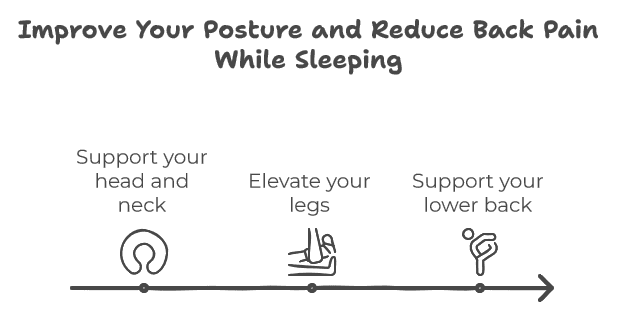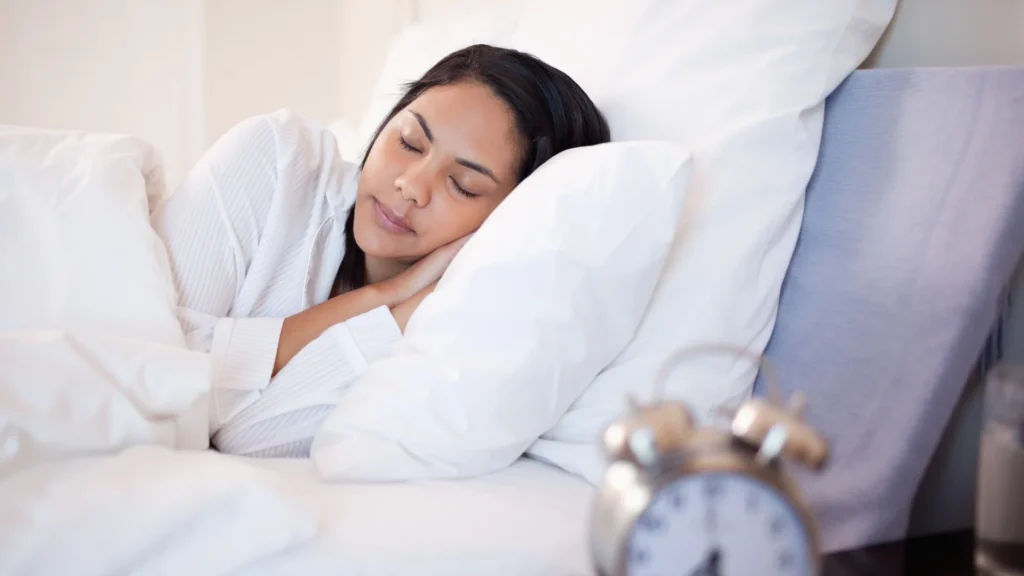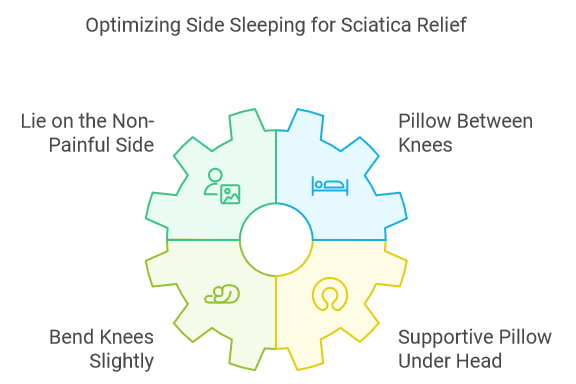If you’re battling sciatica, you know how challenging it can be to find a comfortable sleeping position. The shooting pain from your lower back down your leg can turn bedtime into a nightly struggle.
But don’t lose hope – finding the best sleeping position for sciatica can make a world of difference in your quality of rest and overall pain management.
Today we will explore various sleeping positions that can help alleviate sciatic pain, allowing you to wake up refreshed rather than in agony. We’ll also discuss some helpful products that can support your journey to better sleep.
Whether you’re a back, side or stomach sleeper, we’ve got tips to help you find relief and reclaim your nights.
But first, What is Sciatica?

Sciatica is a condition that affects millions of people worldwide, causing pain that radiates from the lower back down the leg. This discomfort can significantly impact sleep quality, making it crucial to find the best sleeping position for sciatica.
The sciatic nerve, which is the longest nerve in the body, runs from your lower back through your hips and buttocks and down each leg. When this nerve becomes compressed or irritated, it can lead to sciatica symptoms, including:
- Sharp, burning pain in the lower back and leg
- Numbness or tingling in the affected leg
- Weakness in the leg or foot
How does Sciatica affect sleep?
Sleep plays a vital role in managing sciatica pain. During rest, your body has a chance to repair and regenerate tissues, potentially reducing inflammation around the sciatic nerve. Poor sleep, on the other hand, can exacerbate pain and slow down the healing process.
Your sleeping position can either alleviate or worsen sciatic pain. Certain positions may put additional pressure on the sciatic nerve, leading to increased discomfort. Conversely, the right position can help reduce pressure on the nerve, allowing for better sleep and potentially faster recovery.
Finding the best sleeping position for sciatica is not just about comfort; it’s about creating an environment that promotes healing and pain relief. By understanding how sciatica affects your body and how different sleeping positions impact your pain, you can make informed choices to improve your sleep quality and overall well-being.
Sleeping Positions to Avoid
While searching for the best sleeping position for sciatica, it’s equally important to know which positions to avoid. Stomach sleeping is often considered the least favourable position for those suffering from sciatica.
Stomach Sleeping

Sleeping on your stomach can exacerbate sciatic pain for several reasons:
| Issue | Description |
|---|---|
| Spinal Misalignment | Forces neck to twist, potentially misaligning spine and stressing lower back |
| Increased Pressure | Can increase pressure on sciatic nerve, especially with soft mattresses |
| Muscle Strain | May strain lower back muscles, potentially worsening sciatic pain |
Stomach sleeping poses several challenges for those with sciatica. This position forces your neck to twist to one side, potentially misaligning your spine and putting additional stress on your lower back. This spinal misalignment can exacerbate sciatic pain and discomfort.
Moreover, stomach sleeping can increase pressure on the sciatic nerve, particularly if you use a soft mattress that allows your midsection to sink. This increased pressure can lead to more intense pain and discomfort along the sciatic nerve pathway.
Lastly, this sleeping position can strain the muscles in your lower back, potentially worsening sciatic pain. The combination of these factors makes stomach sleeping a less-than-ideal choice for those seeking relief from sciatica symptoms.
If you’re a habitual stomach sleeper, transitioning to a new position can be challenging. Here are some alternatives to consider:
| Strategy | Description | Benefit |
|---|---|---|
| Gradual Transition | Place thin pillow under pelvis | Reduces pressure on sciatic nerve |
| Side Sleeping with Support | Sleep on side with pillow between knees | Maintains proper spinal alignment |
| Back Sleeping | Sleep on back with pillow under knees | Considered best for sciatica, maintains natural spine curvature |
Start with a gradual transition by placing a thin pillow under your pelvis to slightly elevate your lower back, which can help reduce pressure on the sciatic nerve.
Another option is side sleeping with support; try sleeping on your side with a pillow between your knees to maintain proper spinal alignment.
If possible, the most beneficial change would be to transition to back sleeping. This position, with a pillow under your knees, is often considered one of the best sleeping positions for sciatica as it helps maintain natural spine curvature and minimizes pressure on the sciatic nerve.
Therefore, finding the best sleeping position for sciatica may take time and experimentation. Be patient with yourself as you adjust to new sleeping habits, and consult with a healthcare professional if your pain persists or worsens.
Best Sleeping Positions for Sciatica
Sleeping on Your Back

Sleeping on your back is often considered the best sleeping position for sciatica. This position helps maintain the natural curve of your spine and distributes your body weight evenly, reducing pressure on the sciatic nerve.
To maximise the benefits of back sleeping:

- Use a supportive pillow under your head to keep your neck aligned with your spine.
- Place a pillow under your knees to slightly elevate your legs. This helps maintain the natural curve of your lower back and reduces pressure on the sciatic nerve.
- Consider using a small, rolled towel under the small of your back for additional lumbar support.
Benefits of back sleeping for sciatica:

For enhanced comfort, you might consider using a wedge pillow to elevate your legs. This can further reduce pressure on your lower back and sciatic nerve.
If you are looking for a good pillow for back sleeping, the Cushy Form Bed Wedge Pillow provides excellent support for elevating your legs while sleeping on your back. Its gradual slope helps maintain proper alignment and can significantly reduce sciatic pain.
While back sleeping is generally the best sleeping position for sciatica, it may take some time to adjust if you’re not used to it. Be patient and give your body time to adapt. If you find it challenging to stay on your back all night, start with short periods and gradually increase the duration.
Sleeping on Your Side

Side sleeping can be an excellent alternative when seeking the best sleeping position for sciatica. This position, when done correctly, can help alleviate pressure on the sciatic nerve and provide relief from pain.
To optimise side sleeping for sciatica relief:

- Lie on the side that isn’t painful. If both sides are affected, choose the less painful side.
- Place a pillow between your knees to keep your hips, pelvis and spine aligned.
- Slightly bend your knees towards your chest, but avoid curling up too tightly.
- Use a supportive pillow under your head to keep your neck aligned with your spine.
Benefits of side sleeping for sciatica:

For added comfort and support, consider using a body pillow. This can help maintain proper alignment throughout the night and prevent you from rolling onto your back or stomach.
A good pillow for side sleeping is the Snuggle-Pedic Full Body Pillow. It provides excellent full-body support for side sleepers. Its shredded memory foam filling adapts to your body shape, offering customised comfort and support.
While side sleeping can be an effective best sleeping position for sciatica, it’s important to alternate sides if possible to prevent stiffness. If you find one side more comfortable, you can still periodically switch to avoid putting constant pressure on one side of your body.
Thus, finding the right sleeping position may take some trial and error. Be patient and listen to your body as you explore what works best for your sciatica symptoms.
Fetal Position

The fetal position is another option to consider when exploring the best sleeping position for sciatica. This position involves lying on your side with your knees drawn up towards your chest, similar to how a baby curls up in the womb.
To adopt the fetal position effectively:

- Lie on the side that isn’t painful.
- Gently draw your knees towards your chest.
- Place a pillow between your knees for added support.
- Use a supportive pillow under your head to maintain spinal alignment.
Benefits of the fetal position for sciatica:

It’s important to note that while the fetal position can be beneficial, curling up too tightly might increase pain for some people. Listen to your body and adjust accordingly.
The PharMeDoc Pregnancy Pillow, while designed for pregnant women, can be excellent for anyone adopting the fetal position. Its U-shape provides full-body support, helping maintain proper alignment throughout the night.
The fetal position might not be the best sleeping position for sciatica for everyone, but many find it provides significant relief. As with any sleeping position, it may take time to adjust. Start by trying it for short periods and gradually increase as comfort allows.
Remember to alternate sides if possible to prevent stiffness and maintain balance in your body. If you find the fetal position uncomfortable or it exacerbates your pain, try adjusting your leg position or consider other sleeping positions discussed in this article.
Additional Tips for Better Sleep with Sciatica
Using Supportive Pillows

While finding the best sleeping position for sciatica is crucial, using supportive pillows can enhance your comfort and pain relief. Lumbar support pillows are particularly beneficial, as they help maintain the natural curve of your spine while sleeping.
These pillows can be placed under your lower back when sleeping on your back, or between your knees when side sleeping. The Everlasting Comfort Lumbar Support Pillow is an excellent choice. Its memory foam construction adapts to your body shape, providing customised support.
Using supportive pillows in conjunction with the right sleeping position can significantly improve your sleep quality and reduce sciatic pain.
Choosing the Right Mattress

Your mattress plays a vital role in finding the best sleeping position for sciatica. A medium-firm mattress often provides the ideal balance of support and comfort for sciatica sufferers. It helps maintain proper spinal alignment while offering enough cushioning to relieve pressure points.
The Zinus Green Tea Memory Foam Mattress is a popular medium-firm choice. Its memory foam construction adapts to your body shape, providing support where needed most. When choosing a mattress, consider your sleeping position and body weight.
If possible, try out different mattresses before purchasing to ensure you find the most comfortable option for your sciatica.
Pre-sleep Stretches and Exercises

Incorporating pre-sleep stretches and exercises into your routine can complement the best sleeping position for sciatica by relaxing tense muscles and improving flexibility. Gentle stretches like knee-to-chest pulls or pelvic tilts can help alleviate sciatic pain. Using a foam roller before bed can also help release muscle tension and improve circulation.
The TriggerPoint GRID Foam Roller is an excellent tool for this purpose. Its unique design allows for targeted muscle relief. Remember to consult with a healthcare professional before starting any new exercise routine, especially if you have severe sciatica symptoms.
Gentle, consistent pre-sleep exercises can significantly improve your sleep quality and reduce sciatic pain.
Take Action for Better Sleep Tonight
Finding the best sleeping position for sciatica can significantly improve your quality of life. Whether you choose back sleeping, side sleeping or the fetal position, each offers unique benefits for managing sciatic pain.
Remember to use supportive pillows, choose the right mattress and incorporate gentle pre-sleep stretches into your routine. It’s crucial to listen to your body and be patient as you adjust to new sleeping habits.
If your symptoms persist or worsen, don’t hesitate to consult a healthcare professional. Start your journey towards better sleep and reduced sciatic pain tonight by trying one of these recommended positions.
Your body will thank you for taking this important step towards improved comfort and well-being.
Read this next? What is the Best Light Color for Sleep?



